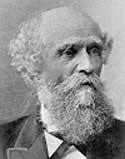the john muir exhibit - people - joseph leconte
Joseph LeConte
1823-1901

- Geologist,
naturalist, and university professor.
- With his brother
John, took part in organizing the University of California.
- A.M., M.D., LL.D. Professor of Geology and Natural History, Honorary Professor of Biology in the College of Dentistry, and Lecturer.
- Elected to
the National Academy of Sciences in 1874.
- Joseph Le Conte first visited Yosemite in 1870 with 10 of his first class of students. There were only 40 students enrolled in the entire University of California at that time. It was on this trip that LeConte met John Muir, who joined part of the "University Excursion Party."
- His son, Joseph N. LeConte, was the photographer of many Sierra Club outings, a trailblazer
and map-maker for what became the John Muir Trail.
- John Muir and
LeConte were life-long friends. Joseph LeConte was one of the first
professional geologists to support Muir's theory of the glacial
origin of Yosemite Valley.
- Joseph and his brother John, and his son "Little Joe," have been remembered with numerous
names in the Sierra Nevada. and elsewhere.
Joseph LeConte the elder is memorialized in the mountains with LeConte
Cascade, "the most majestic cascade” in the Tuolumne River
canyon (named in 1894), and also by Mount LeConte, a peak over 13,900
feet in the Mount Whitney region, named in 1895.
- The Yosemite Conservation Heritage Center - A 100+ year-old National Historic Landmark in Yosemite National Park originally dedicated to Joseph LeConte, who died in the Valley in 1901 at the age of 76 on the eve of the Club's first High Trip. When LeConte's racial theories came to light in 2015, the Sierra Club Board of Directors decided that this public education center, originally named in honor of a man who promoted theories about the inferiority of nonwhite races was counter both to the Sierra Club's values and to the need to promote inclusivity in our national parks. For that reason, the Sierra Club requested that the National Park Service rename the lodge, which is now called the "Yosemite Conservation Heritage Center."